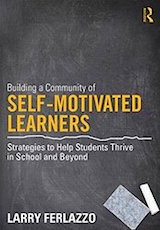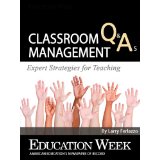Help Your Students Get Into the Learning Flow
Adapted with permission from Chapter 6 of Larry Ferlazzo’s new book Building a Community of Self-Motivated Learners: Strategies to Help Students Thrive in School and Beyond (Routledge, 2015). We’ve included references for Chapter 6 at the end of the post. Specific attributions can be found in the original text.

QUESTION: “I’ve heard about something called ‘flow.’ I think it means being so focused on what you’re doing that you lose track of time. Do you have any suggestions for how I can create conditions in my classroom that would encourage it, and help my students want to seek it out?”
Flow, a term originally coined by professor and researcher Mihaly Csikszentmihalyi, is the highest level of intrinsic motivation – the “optimal experience” (Csikszentmihalyi, 2009). Flow is what people feel when they are enjoying doing an activity so much that they are “being carried away in a current,” says Csikszentmihalyi, and they lose track of time. There are few comments from a student that will warm my heart more than “This class goes so fast!”

Research on student engagement has found a direct connection between frequency of flow experiences and longer-term academic interest and motivation. In addition, Csikszentmihalyi suggests that the happiest people are those who have the most flow experiences.
So, what exactly is flow? How do we recognize it?
Csikszentmihalyi found that there several elements of flow – what people experienced when they were in that state and what conditions were necessary to achieve it. At different times and in different situations it appears he may have made some minor adjustments to the list. This list is an amalgam based on his writing and presentations:
Getting with the flow

- People are concentrating completely on the activity.
- People lose track of time.
- They feel a great sense of intrinsic motivation — doing the activity is its own reward.
- They have a sense of clarity about what needs to be done.
- People forget their worries and concerns.
- There is a feeling like “you’re not doing your everyday routine.”
- They have a sense of control over the actions needed to successfully complete the task (similar to feelings of autonomy and competence that I discuss in my book as prerequisites for intrinsic motivation).
Necessary Conditions to Achieve a State of Flow
- You receive clear and regular feedback from others that enable you to make adjustments to what you are doing.
- You must have a clear goal.
- The activity is challenging to your skill level. Csikszentmihalyi recommends doing something 10 percent outside one’s comfort level to attain a state of flow. His research found that being completely over-matched by a task led to anxiety; doing something too easy resulted in boredom; and a feeling of apathy was experienced when the challenge and the skill of the person were both low. It’s essential to find just the right balance.
The right conditions for flow

In addition, people need to believe that they are in control and have the capability to deal with the task at hand, and part of that means being in a place or situation where they have the autonomy to do so.
Finally, if people are going to feel like they are not in their “everyday routine” – especially in the case of a classroom – we need to remember that, though some “routine” is important to provide to our students (especially to those who have very little of it outside of school), too much of a good thing can be bad.
Good flow and junk flow
Though he hasn’t included it in his well-known list of 10 “criteria” for flow, Csikszentmihalyi has differentiated between what he calls “junk flow” and flow that “makes you grow” (Mihaly Csikszentmihalyi on Flow, 2014).

You can do it faster and faster and play higher and higher levels, but after a while either you can’t go anymore because you are not fast enough, or you wake up one morning and say, “Why the heck am I doing this kind of thing? It just doesn’t give me any hope for the future.” (Mihaly Csikszentmihalyi on Flow, 2014)
Csikszentmihalyi goes on to say:
The meaning is important. The Greek philosopher Plato wrote a thousand years ago that the greatest challenge for teachers and parents is to teach young people to find pleasure in the right things. He called it pleasure, but actually what he meant was enjoyment. The problem is that it’s much easier to find pleasure or enjoyment in things that are not growth-producing but are attractive and seductive.
After a while you get trapped by a cycle of short term bursts of excitement, and then it becomes a habit; and now you feel bad if you can’t play, but you don’t feel good when you can play. That’s a problem that goes beyond flow. It goes to the philosophy of life.” (Mihaly Csikszentmihalyi on Flow, 2014)
How often are people in a state of flow?

Actions teachers can take to increase flow
Demonstrate Enthusiasm and Humor
Studies have found that when educators are experiencing flow in their teaching, their state of flow can “cross over” to students.

Turn Learning Tasks Into Puzzles
Many people derive enjoyment from solving puzzles, and Csikszentmihalyi and others have found that looking at learning tasks and challenges as “puzzles” is a common occurrence among those in a state of flow. Teachers can frame any number of learning activities as a sort of puzzle.
For example, sequencing activities where students have to put cut-up pieces of text into the correct order, or clozes (also known as “gap-fills” or “fill-in-the-gaps”) where readers have to identify correct words that belong in the “blanks.” (Csikszentmihalyi suggests that an even better flow activity would be having students create their own “puzzles” that others can then solve.)
Student readers can even be encouraged to become “lost” in a book is by considering its puzzle elements, including “anticipating turns of the plot” (Csikszentmihalyi, 1990) and imagining alternate endings.
Reduce Interruptions

Separate studies have found that students’ learning appears to be reduced by 20 percent with multiple interruptions – both in information retained and in writing quality. Before teachers disrupt the potential of student flow, we should ask ourselves, “Is the cost of the interruption I am going to make worth what I think is the benefit of students hearing it?”
Create Opportunities for Regular Feedback
In order to enter a flow state, students need to receive regular feedback so they can make any adjustments necessary to complete their goal. This feedback process should avoid interrupting their concentration. Some ways to handle feedback effectively without interrupting flow are:
Teaching students to self-monitor through the use of metacognition. There is a metacognition lesson plan in Self-Driven Learning (Ferlazzo, 2013, 99).
- Providing a rubric that, ideally, has also been developed with some input from students.
- If students are working in small groups, encouraging them to provide candid feedback to each other.
- Teachers providing selective feedback occasionally and not constantly.
[Other immediate actions to help students achieve flow that are discussed in Chapter 6 include the promotion of higher-level thinking, the use of appropriately challenging activities, the use of mental imagery, cooperative and other interactive learning, assuring lesson relevance, and building positive teacher-student relationships.]
What’s in my Flow lesson plan
My Flow Lesson Plan, which is fully presented at the end of Chapter 6, is too detailed to share here. It introduces the concept of “flow” (and its benefits) to students through videos, by having them examine their own prior experiences, and by reading an excerpt from one of Csikszentmihalyi’s books. Students then create a series of specific actions that they and their teacher can do to facilitate a flow state in the classroom.
The lesson, correlated to the Common Core ELA/Literacy Standards, provides a basis to support many of the “immediate actions” included in Chapter 6 and also offers – in the lesson itself and through suggested extension activities – a number of ways teachers can keep the “flow” going throughout the school year.


 Teaching students to self-monitor through the use of
Teaching students to self-monitor through the use of 
































Thank you Mr. Ferlazzo for the great article. I will incorporate some of your suggestions in my next hands-on workshop with my students to see if I can get them in the “flow” and make it more interactive.
These are some very useful thoughts. I often drop into a classroom for one or two days to give an arts integrated lesson, and the concept of ‘flow’ is something I love to discuss with students as an artistic concept. I often start students off with an abstract scribbling exercise where I encourage them to try to find some flow expressing their emotions, or the emotions of a character in a book they are reading.
Students tend to be very open to the concept of ‘flow’ in art. This article makes me want to get them to think about the ‘flow’ concept in many other modes of learning.
Thank you!
This is a great article, thank you!! I have been teaching 7th grade ELA for 10 years and have come to the sad realization that many students do not like English. Don’t get me wrong, there are some that do…but to many of them, English Language Arts is a challenge. It’s difficult because many of my students struggle with reading and they just tend to give up instead of working at it. And most would realize that if they struggle with just reading, then they’re going to really struggle with the assignment or project that follows the reading. I’ve noticed that many of my students who are intrinsically motivated are those who love to read and do well in ELA.
So my question would be: how do we get those students who struggle engaged in an activity where they feel that sense of intrinsic motivation? I do many activities that are more than just reading from the book and answering questions; yet I have students who would rather sit and not do anything for 2 periods. It doesn’t seem to matter what I have planned or what we do; they just sit and do absolutely nothing.
I liked the quote from Csikszentmihalyi, about one of the greatest challenges for teachers is how to “…teach young people to find pleasure in the right things.” I would love an answer to this one!!
I enjoyed reading about turning learning tasks into puzzles. This is an idea I’d like to bring into my class perhaps when we read short stories or our novel. It also hit me when you shared about interruptions. I’m a so guilty of this. I will get my students working on something and then forget to tell them something, so I interrupt them and tell them what I need to share. I never thought about how that can ruin their “flow.” Now I will be more conscious of doing this. Lastly, when I read about the opportunities for regular feedback that hit home. I’m not the best at this. I think letting students give input in a rubric would get them more involved and for me to provide more feedback would also help create intrinsic motivation.
So now I will work on creating a frequency of flow experiences to increase intrinsic motivation! Thanks so much!! Oh and I think I’m going to get your book, I bet it’s a pretty good read!! :-)